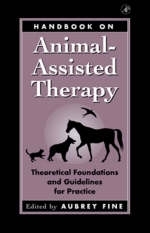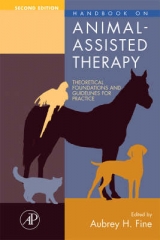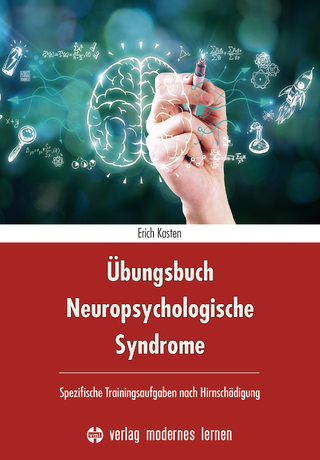
Handbook on Animal Assisted Therapy
Academic Press Inc (Verlag)
978-0-12-256475-8 (ISBN)
- Titel erscheint in neuer Auflage
- Artikel merken
Handbook on Animal-Assisted Therapy provides a comprehensive overview of the many ways in which animals can be used to assist therapists. Coverage includes how animals can assist specific patient populations (children, the disabled, AIDS patients, etc.), how animals can aid in specific settings (hospitals, prisons, independent practice, etc.), and how professionals can best select appropriate animals (species, breed, and individual temperament) and design an AAT program. Humans have long had a special bond with animals, initially as work animals, then as pets, and now more frequently as therapeutic companions. Animals help the sick recover more quickly and help the aged live longer and more satisfying lives. Specially trained animals are now helping stroke victims, the handicapped, and others to regain or build lost faculties. Increasingly, animals assist in nonphysical/medical therapies, helping the stressed and angry relax and the shy be more forthcoming. Contributors represent the top people in the field from hospital settings, vet hospitals, animal training centers, and therapists in practice.
CContributors. Foreward. Preface. The Conceptualization of the Animal-Human Bond: The Foundation for Understanding Animal-Assisted Therapy: J.A. Serpell, Animal Companions and Human Well-Being: An Historical Exploration of the Value of Human-Animal Relationships. A.M. Beck, The Use of Animals to Benefit Humans: Animal-Assisted Therapy. E. Friedmann, The Animal-Human Bond: Health and Wellness. L.A. Hart, Psychosocial Benefits of Animal Companionship. Animal-Assisted Therapy: Conceptual Model and Guidelines for Quality Assurance: Methods, Standards, Guidelines, and Considerations in Selecting Animals for Animal-Assisted Therapy: L.A. Hart, Part A: Understanding Animal Behavior, Species, and Temperament as Applied to Interactions with Specific Populations. M. Fredrickson and A.R. Howie, Part B: Guidelines and Standards for Animal Selection in Animal-Assisted Activity and Therapy Programs. G.P. Mallon, S.B. Ross, Jr., and L. Ross, Designing and Implementing Animal-Assisted Therapy Programs in Health and Mental Health Organizations. M.R. Burch, Program Evaluation and Quality Assurance in Animal-Assisted Therapy. Best Practices in Animal-Assisted Therapy: Guidelines for Use of AAT with Special Populations: A.H. Katcher and G.G. Wilkins, The Centaur's Lessons: Therapeutic Education through Care of Animals and Nature Study. A.H. Fine, Animals and Therapists: Incorporating Animals in Outpatient Psychotherapy. B.P. Granger and L. Kogan, Animal-Assisted Therapy in Specialized Settings. M.M. Baun and B.W. McCabe, The Role Animals Play in Enhancing Quality of Life for the Elderly. K. Gorczyca, A.H. Fine, and C.V. Spain, History, Theory, and Development of Human-Animal Support Services for People with AIDS and Other Chronic/Terminal Illnesses. S.L. Duncan and K. Allen, Service Animals and Their Roles in Enhancing Independence, Quality of Life, and Employment for People with Disabilities. F.R. Ascione, M.E. Kaufmann, and S.M. Brooks, Animal Abuse and Developmental Psychopathology: Recent Research, Programmatic, and Therapeutic Issues and Challenges for the Future. Special Topics and Concerns in Animal-Assisted Therapy: S.L. Triebenbacher, The Companion Animal within the Family System: The Manner in Which Animals Enhance Life within the Home. G.F. Melson, Companion Animals and the Development of Children: Implications of the Biophilia Hypothesis. L. Nebbe, Nature Therapy. J. Serpell, R. Coppinger, and A.H. Fine, The Welfare of Assistance and Therapy Animals: An Ethical Comment. P. Arkow, Synergy and Symbiosis in Animal-Assisted Therapy: Interdisciplinary Collaborations. The Future of Education and Research on the Animal-Human Bond and Animal-Assisted Therapy. D.C. Turner, Part A: The Role of Ethology in the Field of Human-Animal Relations and Animal-Assisted Therapy. A.H. Katcher, Part B: Animal-Assisted Therapy and the Study of Human-Animal Relationships: Discipline or Bondage? Context or Transitional Object? Index.
| Erscheint lt. Verlag | 29.10.1999 |
|---|---|
| Zusatzinfo | Illustrations |
| Verlagsort | San Diego |
| Sprache | englisch |
| Maße | 152 x 229 mm |
| Gewicht | 840 g |
| Themenwelt | Medizin / Pharmazie ► Medizinische Fachgebiete |
| Medizin / Pharmazie ► Naturheilkunde | |
| Medizin / Pharmazie ► Physiotherapie / Ergotherapie ► Ergotherapie | |
| Naturwissenschaften ► Biologie ► Zoologie | |
| Sozialwissenschaften ► Pädagogik ► Sozialpädagogik | |
| Sozialwissenschaften ► Soziologie | |
| ISBN-10 | 0-12-256475-8 / 0122564758 |
| ISBN-13 | 978-0-12-256475-8 / 9780122564758 |
| Zustand | Neuware |
| Haben Sie eine Frage zum Produkt? |
aus dem Bereich



